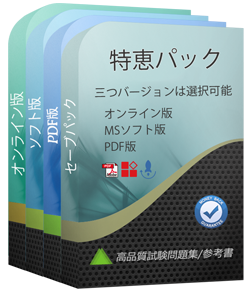返金するポリシーはありますか? 失敗した場合、どうすれば返金できますか?
はい。弊社はあなたが我々の練習問題を使用して試験に合格しないと全額返金を保証します。返金プロセスは非常に簡単です:購入日から60日以内に不合格成績書を弊社に送っていいです。弊社は成績書を確認した後で、返金を行います。お金は7日以内に支払い口座に戻ります。
あなたのテストエンジンはどのように実行しますか?
あなたのPCにダウンロードしてインストールすると、IBM C1000-185テスト問題を練習し、'練習試験'と '仮想試験'2つの異なるオプションを使用してあなたの質問と回答を確認することができます。
仮想試験 - 時間制限付きに試験問題で自分自身をテストします。
練習試験 - 試験問題を1つ1つレビューし、正解をビューします。
Tech4Examはどんな試験参考書を提供していますか?
テストエンジン:C1000-185試験試験エンジンは、あなた自身のデバイスにダウンロードして運行できます。インタラクティブでシミュレートされた環境でテストを行います。
PDF(テストエンジンのコピー):内容はテストエンジンと同じで、印刷をサポートしています。
購入後、どれくらいC1000-185試験参考書を入手できますか?
あなたは5-10分以内にIBM C1000-185試験参考書を付くメールを受信します。そして即時ダウンロードして勉強します。購入後にC1000-185試験参考書を入手しないなら、すぐにメールでお問い合わせください。
更新されたC1000-185試験参考書を得ることができ、取得方法?
はい、購入後に1年間の無料アップデートを享受できます。更新があれば、私たちのシステムは更新されたC1000-185試験参考書をあなたのメールボックスに自動的に送ります。
C1000-185テストエンジンはどのシステムに適用しますか?
オンラインテストエンジンは、WEBブラウザをベースとしたソフトウェアなので、Windows / Mac / Android / iOSなどをサポートできます。どんな電設備でも使用でき、自己ペースで練習できます。オンラインテストエンジンはオフラインの練習をサポートしていますが、前提条件は初めてインターネットで実行することです。
ソフトテストエンジンは、Java環境で運行するWindowsシステムに適用して、複数のコンピュータにインストールすることができます。
PDF版は、Adobe ReaderやFoxit Reader、Google Docsなどの読書ツールに読むことができます。
あなたはC1000-185試験参考書の更新をどのぐらいでリリースしていますか?
すべての試験参考書は常に更新されますが、固定日付には更新されません。弊社の専門チームは、試験のアップデートに十分の注意を払い、彼らは常にそれに応じてC1000-185試験内容をアップグレードします。
割引はありますか?
我々社は顧客にいくつかの割引を提供します。 特恵には制限はありません。 弊社のサイトで定期的にチェックしてクーポンを入手することができます。
IBM watsonx Generative AI Engineer - Associate 認定 C1000-185 試験問題:
1. You are designing a Retrieval-Augmented Generation (RAG) system that will handle real-time queries from users, using a combination of a retriever and a transformer-based generator.
Which of the following implementation details is the most critical to ensure that the system delivers responses in a timely manner while maintaining accuracy?
A) The retriever and generator should operate independently of each other to avoid communication overhead.
B) The retriever should utilize an efficient vector search algorithm with approximate nearest neighbor (ANN) techniques to balance speed and accuracy.
C) The retriever should use exact match algorithms to minimize retrieval time and complexity.
D) The system should cache previous queries and responses to avoid invoking the retriever and generator multiple times.
2. You are fine-tuning a generative AI model using Tuning Studio for a legal document analysis task. The model needs to perform well in summarizing long, complex legal texts while minimizing the amount of computational resources used. You are tasked with optimizing the tuning process to ensure maximum efficiency and model accuracy.
Which of the following actions would most effectively optimize the tuning process in Tuning Studio for this task?
A) Using a fixed number of training epochs to ensure consistent results across tuning iterations.
B) Adjusting the learning rate dynamically during training based on the model's real-time loss values.
C) Increasing the batch size to reduce the number of gradient updates during training, thus speeding up the process.
D) Reducing the number of layers in the model to decrease computational overhead.
3. In a generative AI model, you are tasked with producing creative yet coherent text for a marketing campaign. You want to ensure that the output contains varied word choices and diverse sentence structures while still maintaining some degree of logical consistency.
Which of the following settings for the temperature parameter would most likely achieve this balance?
A) Temperature = 0.0
B) Temperature = 0.7
C) Temperature = 2.0
D) Temperature = 0.2
4. You are developing a machine learning pipeline using IBM watsonx that includes fine-tuning an LLM with a dataset containing sensitive personal information. To ensure privacy, you decide to apply differential privacy.
Which of the following actions is most critical to configure in the user interface to meet the differential privacy requirements during model fine-tuning?
A) Apply a differential privacy mechanism that adds calibrated noise to both the model updates and synthetic data generation process.
B) Use synthetic data only, which eliminates the need for differential privacy as it does not contain real user information.
C) Remove differential privacy settings for fine-tuning, but apply them in the final inference model to reduce performance degradation.
D) Increase the learning rate and batch size to maximize the noise added by differential privacy algorithms.
5. When creating a prompt-tuned model, which of the following factors is most critical to ensure that the model generates accurate and contextually relevant responses?
A) Ensuring that the prompt length does not exceed the model's input token limit.
B) Using a diverse set of unrelated tasks in the tuning dataset to increase model generalization.
C) Matching the training data prompts as closely as possible to real-world deployment scenarios.
D) Employing low learning rates to prevent the model from adapting too quickly to new prompts.
質問と回答:
| 質問 # 1 正解: B | 質問 # 2 正解: B | 質問 # 3 正解: B | 質問 # 4 正解: A | 質問 # 5 正解: C |


 弊社は製品に自信を持っており、面倒な製品を提供していません。
弊社は製品に自信を持っており、面倒な製品を提供していません。



 -Ootsuka
-Ootsuka

